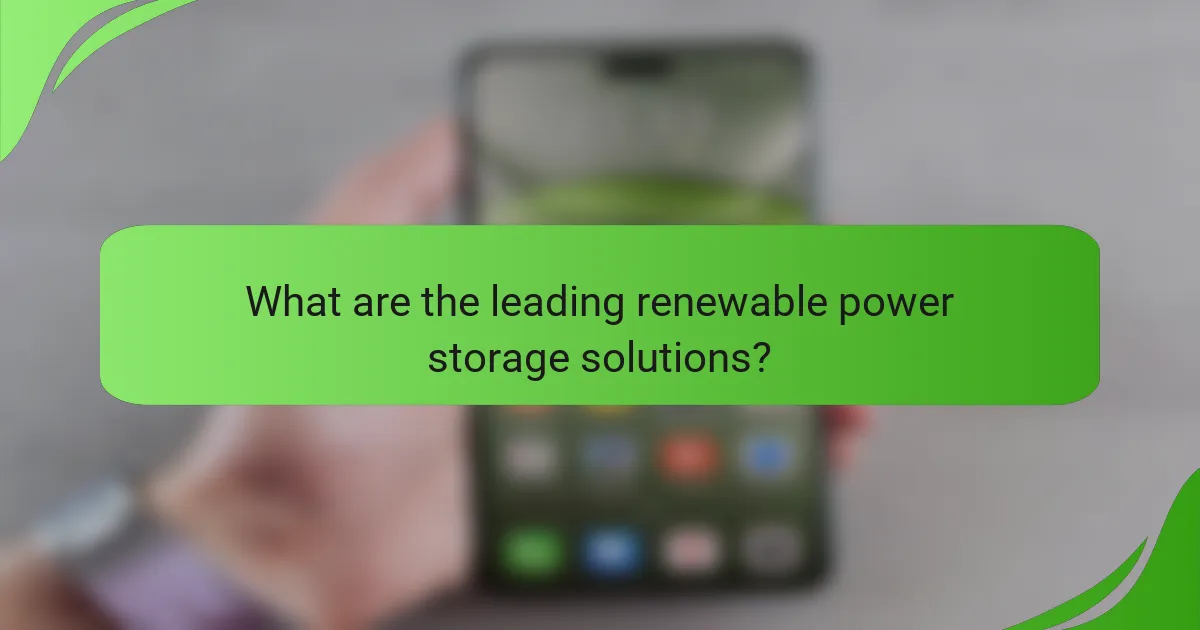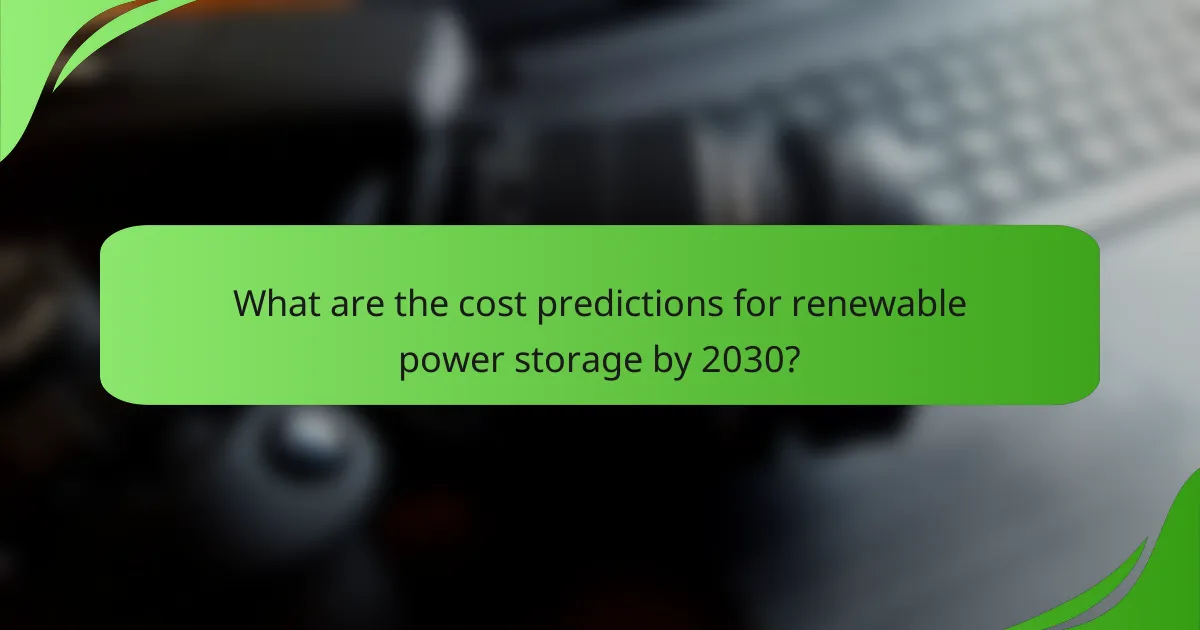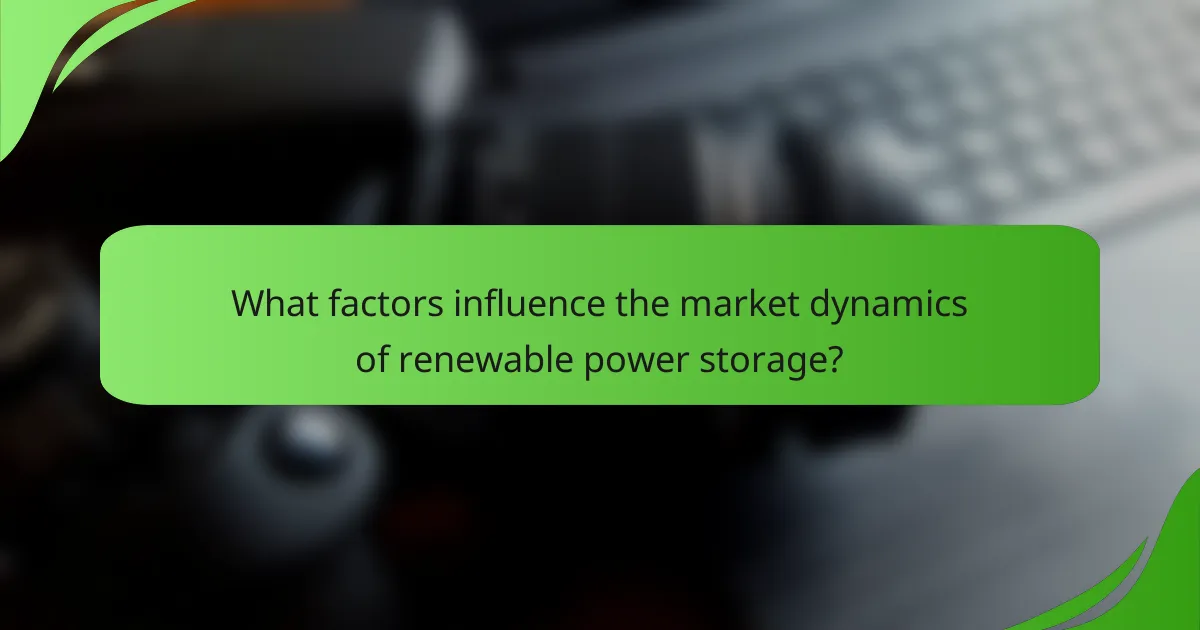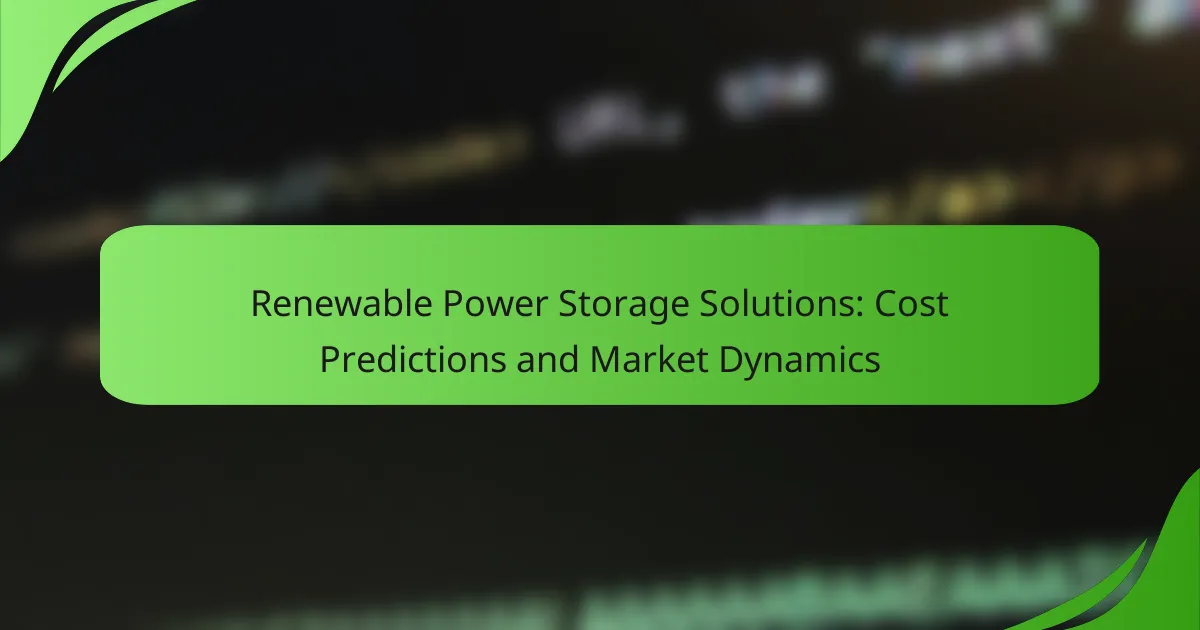Renewable power storage solutions, including lithium-ion batteries, pumped hydro storage, and flow batteries, play a crucial role in enhancing energy efficiency and stabilizing costs in the renewable energy market. As technology advances and production capacity increases, the costs associated with these storage systems are projected to decrease significantly by 2030, making them more accessible and competitive. This evolution will not only reduce reliance on expensive peak power sources but also lower overall energy expenses for consumers.

What are the leading renewable power storage solutions?
The leading renewable power storage solutions include lithium-ion batteries, pumped hydro storage, flow batteries, compressed air energy storage, and solid-state batteries. Each solution has unique characteristics, advantages, and considerations that influence their deployment in renewable energy systems.
Lithium-ion batteries
Lithium-ion batteries are the most widely used energy storage technology due to their high energy density and efficiency. They are commonly employed in applications ranging from electric vehicles to grid storage, providing quick response times and scalability.
However, the cost of lithium-ion batteries can vary significantly, typically ranging from hundreds to a few thousand USD per kilowatt-hour. Factors such as raw material prices and technological advancements can influence these costs.
Pumped hydro storage
Pumped hydro storage is a mature technology that uses two water reservoirs at different elevations to store energy. During low demand, excess energy pumps water uphill; during peak demand, the water is released to generate electricity.
This method is highly efficient, often exceeding 70%, and can provide large-scale storage. However, it requires significant geographical considerations and infrastructure investment, making it less feasible in urban areas.
Flow batteries
Flow batteries store energy in liquid electrolytes, allowing for scalable storage capacity and long discharge times. They are particularly suitable for applications requiring longer-duration energy storage, such as renewable energy integration and grid stabilization.
While flow batteries have a lower energy density compared to lithium-ion batteries, their longer lifespan and ability to decouple power and energy capacity can make them a cost-effective choice for specific applications.
Compressed air energy storage
Compressed air energy storage (CAES) involves using excess energy to compress air in underground caverns or tanks. When energy is needed, the compressed air is released, driving turbines to generate electricity.
CAES systems can provide large-scale storage but require suitable geological formations and significant capital investment. Efficiency rates typically range from 60% to 70%, depending on the technology used.
Solid-state batteries
Solid-state batteries are an emerging technology that replaces the liquid electrolyte in traditional batteries with a solid electrolyte. This innovation can enhance safety, energy density, and longevity.
While still in development, solid-state batteries hold promise for future renewable energy storage solutions, potentially reducing costs and improving performance as manufacturing processes advance and scale up.

How do renewable power storage solutions impact energy costs in the US?
Renewable power storage solutions significantly influence energy costs in the US by enabling more efficient energy use and reducing reliance on expensive peak power sources. By storing energy generated during low-demand periods, these systems help stabilize prices and lower overall energy expenses for consumers.
Lowering peak demand costs
Renewable power storage can lower peak demand costs by discharging stored energy during high-demand periods. This reduces the need for utilities to activate costly peaker plants, which are typically less efficient and more expensive to operate. As a result, consumers can benefit from lower electricity bills, particularly during peak hours.
For instance, energy storage systems can be strategically deployed to release power when demand surges, effectively flattening the demand curve and minimizing spikes in energy prices. This can lead to savings of up to 20% on peak demand charges for businesses and households alike.
Reducing energy price volatility
Energy storage solutions play a crucial role in reducing price volatility by providing a buffer against sudden fluctuations in supply and demand. By storing excess energy generated from renewable sources, these systems can release power back into the grid when prices spike, helping to stabilize the market.
In practice, this means that during periods of high demand or low renewable generation, stored energy can be utilized to maintain a steady supply. This not only protects consumers from sharp price increases but also encourages investment in renewable technologies, as the financial risks associated with price volatility are mitigated.
Enabling renewable energy integration
Integrating renewable energy sources into the grid is facilitated by energy storage solutions, which help manage the intermittent nature of resources like solar and wind. By storing energy when production exceeds demand, these systems ensure that renewable energy can be effectively utilized even when generation is low.
For example, during sunny days, solar energy can be stored and used during the night or cloudy periods, maximizing the use of clean energy. This capability not only enhances grid reliability but also contributes to long-term cost reductions as the share of renewables in the energy mix increases, ultimately leading to a more sustainable energy future.

What are the cost predictions for renewable power storage by 2030?
By 2030, the costs associated with renewable power storage are expected to decrease significantly, making these technologies more accessible and competitive. Factors such as advancements in battery technology and increased production capacity will drive these changes, potentially lowering costs by 50% or more compared to current levels.
Decreasing battery costs
The cost of batteries, particularly lithium-ion batteries, is projected to decline as manufacturing processes improve and economies of scale are realized. Current estimates suggest that prices could fall to around $100 per kilowatt-hour (kWh) by 2030, making energy storage solutions more viable for both residential and commercial applications.
In addition to lithium-ion, alternative technologies like solid-state batteries and flow batteries are gaining traction, which may further diversify the market and provide additional cost benefits. As these technologies mature, they could offer longer life cycles and better performance at competitive prices.
Projected market growth rates
The renewable power storage market is anticipated to grow at a compound annual growth rate (CAGR) of around 20% through the end of the decade. This growth is driven by increasing demand for renewable energy sources and the need for reliable storage solutions to manage supply and demand effectively.
As governments worldwide implement policies to support clean energy initiatives, investment in storage technologies is expected to surge. Regions like Europe and North America are leading this charge, with significant funding directed towards innovative storage projects and infrastructure development.
Cost comparison with fossil fuels
As renewable power storage costs decrease, they will become increasingly competitive with fossil fuel alternatives. Currently, the levelized cost of electricity (LCOE) for renewables, when paired with storage, is approaching parity with traditional fossil fuel sources in many markets.
For instance, regions that rely heavily on coal or natural gas may find that integrating battery storage with solar or wind energy can reduce overall energy costs, especially during peak demand periods. This shift not only supports economic savings but also aligns with global efforts to reduce carbon emissions and combat climate change.

What factors influence the market dynamics of renewable power storage?
The market dynamics of renewable power storage are influenced by several key factors, including government policies, technological advancements, and supply chain constraints. Understanding these elements is crucial for stakeholders aiming to navigate the evolving landscape of energy storage solutions.
Government policies and incentives
Government policies play a significant role in shaping the market for renewable power storage. Incentives such as tax credits, grants, and subsidies can lower the initial investment costs for storage technologies, making them more attractive to consumers and businesses alike.
For example, in the European Union, various member states offer financial incentives for battery storage systems, which can reduce payback periods and encourage adoption. Additionally, regulations that mandate renewable energy integration can further drive demand for effective storage solutions.
Technological advancements
Technological advancements are critical in enhancing the efficiency and cost-effectiveness of renewable power storage systems. Innovations in battery chemistry, such as lithium-ion and solid-state batteries, have improved energy density and lifespan, making storage solutions more viable for a broader range of applications.
Moreover, developments in grid management technologies allow for better integration of renewable sources with storage systems, optimizing energy use and reducing waste. As these technologies continue to evolve, they are likely to lower costs and expand market opportunities.
Supply chain constraints
Supply chain constraints can significantly impact the availability and pricing of renewable power storage solutions. Factors such as raw material shortages, manufacturing bottlenecks, and transportation issues can lead to increased costs and delays in product availability.
For instance, the global demand for lithium, a key component in many batteries, has surged, leading to price volatility and supply challenges. Stakeholders should consider these constraints when planning investments in storage technologies, as they can affect both short-term and long-term market dynamics.

How to choose the right renewable power storage solution?
Selecting the appropriate renewable power storage solution involves assessing your energy needs, budget, and the specific characteristics of available technologies. Key factors include capacity, discharge rates, lifespan, and environmental impact.
Understanding different types of storage technologies
Renewable power storage solutions primarily include batteries, pumped hydro storage, and thermal storage. Batteries, such as lithium-ion and flow batteries, are popular for their versatility and efficiency. Pumped hydro storage, while requiring significant infrastructure, offers large-scale energy storage capabilities. Thermal storage systems store energy in the form of heat, often using materials like molten salt.
Evaluating capacity and discharge rates
Capacity refers to the total energy a storage system can hold, while discharge rates indicate how quickly that energy can be released. For residential applications, a battery with a capacity of 10-15 kWh is often sufficient, allowing for overnight energy use. In contrast, commercial systems may require hundreds of kWh, necessitating a careful analysis of both capacity and discharge rates to meet demand.
Considering lifespan and maintenance
The lifespan of renewable storage solutions varies significantly. Lithium-ion batteries typically last 10-15 years, while pumped hydro systems can operate for several decades with proper maintenance. Regular maintenance is crucial for maximizing lifespan and efficiency, particularly for thermal storage systems that may require periodic inspections and material replacements.
Analyzing costs and financial incentives
Costs for renewable power storage solutions can vary widely. For instance, residential battery systems may range from $5,000 to $15,000, depending on capacity and installation. Many regions offer financial incentives, such as tax credits or rebates, which can significantly reduce upfront costs. Research local programs to identify available support that can ease the financial burden.
Assessing environmental impact
When choosing a storage solution, consider its environmental impact. Lithium-ion batteries, while efficient, involve resource extraction and potential recycling challenges. Pumped hydro storage can disrupt local ecosystems, while thermal storage often has a lower environmental footprint. Evaluate the full lifecycle of each technology to make an informed decision that aligns with sustainability goals.
